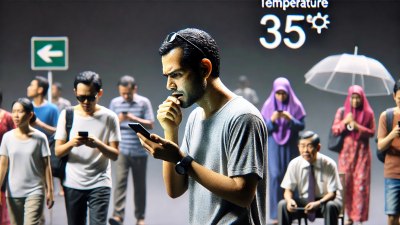Why Do We Always Check the Temperature Even If We Feel It
Exploring the reasons behind checking temperature despite our own sensations.

This image was created with the assistance of DALL·E
Temperature regulation is one of the most fundamental aspects of maintaining homeostasis in the human body. Our ability to perceive temperature allows us to make quick decisions regarding our environment and comfort. However, even when we think we can gauge temperature accurately based on our senses, we often find ourselves reaching for a thermometer. This article delves into the reasons behind why we always check the temperature, despite our innate ability to sense temperature changes.
The Human Sensory System
To understand why we check the temperature, it's essential to consider how our sensory systems work. The human body is equipped with a variety of thermoreceptors located in the skin and deeper tissues. These receptors provide feedback regarding external and internal temperature, allowing us to feel hot, warm, cool, or cold. However, our perception of temperature can be influenced heavily by several factors, including humidity, air movement, the presence of clothing, and even our mental state.
The Limitations of Human Perception
While we might feel hot or cold, our judgment can be flawed. The brain interprets sensory information but is not always accurate. For instance, the acclimatization process can dull our senses; a person may feel warm in a hot room after a few minutes, even though the temperature remains unchanged. Moreover, subjective feelings can differ greatly; one person might feel comfortable at a specific temperature while another feels too cold or hot. This inconsistency highlights the limitations of self-perceived temperature.
Environmental Factors Impacting Temperature Perception
Several environmental conditions can deceive our temperature perception. High humidity can intensify feelings of heat, while a cool breeze can often make a warm day feel significantly more pleasant. Furthermore, the radiant temperature from objects in our environment can also affect how we perceive the air temperature around us. For instance, standing near a warm surface may cause discomfort, while surrounding cooler air can create a feeling of relief. Thus, our senses may conflict with the actual measured temperature, making checking the temperature essential.
Why Devices Are More Reliable
Temperature measuring devices like thermometers provide an objective measure of temperature, eliminating personal biases and imperfections in human perception. These devices can be finely tuned to measure temperature with a degree of accuracy that the human body simply cannot replicate. Digital thermometers, infrared thermometers, and even smart home devices provide readings that can be trusted far more than our subjective feelings. When accuracy is essential, such as in medical instances or when dressing for the day, using a thermometer is crucial.
Health Monitoring and Illness Assessment
One of the most practical applications of temperature checking lies in health monitoring. A fever can signal an underlying issue that requires medical attention, and taking a precise temperature can help evaluate the severity of an illness. When feeling unwell, relying solely on how warm or cool we feel can lead to incorrect conclusions. Regularly checking temperature when symptomatic provides clear data that can inform treatment decisions. Parents often check their children’s temperatures when they exhibit signs of illness to gauge whether they should seek further medical advice.
Psychological Comfort and Assurance
Additionally, the act of checking temperature can serve as a psychological comfort. For many, knowing the exact temperature can alleviate anxiety about the conditions around them. For example, during extreme weather events, checking the temperature can provide peace of mind, ensuring one is adequately prepared for the conditions ahead. This behavior can become even more pronounced in uncertain climates as a means to cope with anxiety or to ensure safety.
Impact of Technology on Temperature Measurement
The evolution of technology has greatly influenced how and why we check temperatures. With various smart devices monitoring our environments, we have access to real-time temperature readings that can be relied upon for various activities—whether it's cooking, assessing weather conditions, or maintaining comfort in our living spaces. For instance, smart thermostats learn our preferences and can adjust accordingly to deliver consistent comfort, often using temperature checks as a foundation for their operations.
The Role of Temperature in Daily Life
Temperature plays an integral role in daily life, from clothing choices to productivity levels. During multitasking or requiring focus, discomfort due to an incorrect ambient temperature can distract from tasks. By checking the temperature, individuals can make informed decisions; whether to layer up or down, adjust the thermostat, or seek a different environment altogether. Temperature awareness can also influence social situations, like gathering outdoors during pleasant weather or retreating indoors when conditions become unfavorable.
Behavioral Patterns Related to Temperature Checking
Behavioral patterns around temperature checking can reveal insights into how we interact with our environments. Individuals who engage in outdoor activities may develop a habit of checking the temperature to optimize their experience—dressing appropriately or planning events around favorable conditions. Such behaviors also tap into our instinct for preparation and avoidance of discomfort. By consistently checking the temperature, we are engaging in a proactive approach to our environment that enhances our quality of life.
The Importance of Temperature in Various Professions
Certain professions necessitate strict temperature monitoring. Medical professionals consistently check patient temperatures as part of standard operating procedures, while chefs need precise oven and food temperatures to ensure safety and quality. In industrial contexts, temperature control can be vital for preventing equipment failure or ensuring quality control in manufacturing processes. This underscores the importance of accurate temperature measurement across various fields and challenges the reliability of human perception in these significative scenarios.
Balancing Sensation and Measurement
In conclusion, despite possessing a natural ability to perceive temperature changes, we often check temperatures using thermometers and other instruments because our perceptions can falter. The complexity and variability inherent in human sensitivity necessitate a reliable, objective measure of temperature for effective decision-making. This harmony between our sensory perceptions and technological advancements allows us to navigate our environments better, ensuring comfort, health, and safety. Thus, checking the temperature becomes an essential practice in a world where both subjective experiences and scientific measurements guide our daily choices.











